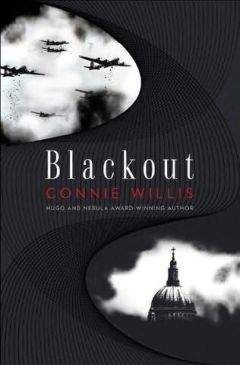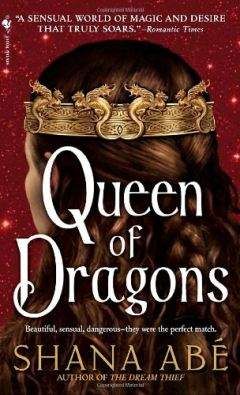We’re nearly there, she thought, but moments later the bus turned sharply to the right away from it. She leaned over the side to look down at the street. It was blocked off with sawhorses and notices reading This Area Off-Limits.
There must be bomb damage ahead. The bus drove down two streets and turned east again, but that way was blocked, too, with a rope and a hand-lettered notice reading Danger, and when the bus stopped, a black-helmeted policeman came over to confer with the driver, after which he pulled the bus over to the curb, and passengers began to disembark. Was it a raid? She hadn’t heard anything, but Colin had warned her that engine sounds sometimes drowned the sirens out, and everyone seemed to be getting off. Polly ran down the winding steps. “Is it a raid?” she asked the driver.
He shook his head, and the policeman said, “Unexploded bomb. This entire area’s cordoned off. Where were you going, miss?”
“St. Paul’s.”
“You can’t go there. That’s where the UXB is. It fell in the road next to the clock tower and burrowed into the foundations. It’s under the cathedral.”
No, it’s not. It’s already been removed, but she could scarcely tell them that.
“I’m afraid you’ll have to go there another time, miss,” the policeman said, and the driver added, “This bus can take you back to Piccadilly Circus, or you can take the tube from Blackfriars. It’s just down there.” He pointed down the hill to where she could see an Underground station.
“Thank you. That’s what I’ll do,” Polly said and walked in the direction he’d pointed down to the first side street, then glanced back to see if they were watching. They weren’t. She ducked down the side street and walked quickly to the next street and back up the hill, looking for a way through the barricade. She wasn’t worried about being seen, except by the policemen. This area was all offices and warehouses. It would be deserted on a Sunday. That was how the fire on the twenty-ninth had got out of control. That had been a Sunday, too, and there’d been no one there to put out the incendiaries.
There was a policeman standing guard at the end of this street as well, so she cut over to the next one, which led into a maze of narrow lanes. It was easy to see why this had burned. The warehouses were mere feet apart. Flames could easily jump from building to building, from street to street. She couldn’t see the cathedral’s dome or west towers, but the lane she was on led uphill, and through the obscuring white paint on the curb, she could make out “Amen Corner.” She must be getting near it.
She was. Here was Paternoster Row. She started along it, keeping close to the buildings so she could duck into a doorway if necessary, and there was the front of St. Paul’s, with its wide steps and broad pillared porch.
But Mr. Dunworthy had been wrong about how long it had taken to remove the UXB, because a lorry and two fire pumpers stood in the courtyard, and just past the end of the steps was a huge hole surrounded by heaps of yellow clay littered with shovels, winches, pickaxes, planks. Two men in clay-covered coveralls were inching ropes down into the hole, two held fire hoses at the ready, and several more, some in clerical collars, watched in strained attention. The bomb was obviously still down there, and from the looks on the bomb squad’s faces, liable to go off at any moment.
But it hadn’t. They’d successfully got it out and taken it to Hackney Marshes to be detonated. Which meant it was perfectly safe to be here and go inside whether they had the bomb out or not. If she could only get past them without being seen.
She looked over at the cathedral doors at the top of the wide steps. They appeared too heavy to open quickly-and silently-even if they weren’t locked.
A man’s voice shouted, “I can’t-where’s that damned-?” and cut off abruptly, followed by a hollow, heart-stopping thud.
Oh, God, they’ve dropped it, Polly thought, and then, Mr. Dunworthy was wrong about how long it took to get it out. What if he was wrong about the bomb going off as well?
But if the bomb had gone off, the cathedral would have collapsed. There’d have been no valiant effort to save it on the night of December twenty-ninth, no morale-lifting photograph of it standing defiant above the flames and smoke, the symbol of England’s determination and refusal to surrender. And the Blitz-and the war-would have gone very differently.
All those thoughts had gone through her head in the fraction of a second it had taken her to look over at the hole and realize the thud hadn’t come from there. The men were still lowering the ropes inch by inch, still watching. She looked back at the porch. A man in a long black cassock and a tin helmet appeared from behind one of the pillars and hurried across the porch toward the hole, carrying a crowbar.
There’s another door there, behind that pillar. Its opening was what I heard, she thought, and as soon as the clergyman reached the end of the porch and started down the side steps, she crept out of the doorway to look, keeping a sharp eye on the group of men. But no one looked up, not even when the clergyman handed the crowbar to one of the firemen.
Yes, there was the door, smaller than the central doors and obviously not locked, but there might still be someone inside, and if they caught her, what could she say, that she somehow hadn’t noticed the barricades and the pumpers and the firemen? If she got arrested… But she was so close. She started cautiously across the courtyard.
“Stop!” someone shouted, and Polly froze, but they weren’t looking at her. They were staring intently down at the hole. The men had ceased to lower the ropes, and a fireman was down on one knee, his hands cupped around his mouth, shouting down into the hole. “Try it to the left.”
It’s stuck, Polly thought, and sprinted across the courtyard, up the broad steps and across the porch, and yanked on the door. It was so heavy she thought for a moment it was locked after all, but then it gave, and she was through it and easing the door silently shut behind her.
She was in a dark, narrow vestibule. She stood there for a moment, listening, but the only sound was the audible hush of a large building. She tiptoed out of the vestibule into the side aisle and looked out into the nave. A wooden admissions desk stood there, but no one was manning it, and there was no one in the north aisle.
Polly stepped out into the nave. And gasped.
Mr. Dunworthy had said St. Paul’s was unique, and she’d seen vids and photographs, but they hadn’t begun to convey how beautiful it was. Or how vast. She’d expected a narrow-aisled Gothic church, but this was wide and airy. The nave stretched away in a series of rounded arches supported by massive rectangular pillars, revealing vista after vista-dome, choir, chancel, altar-all of them lit with a rich, warm golden light that streamed from curved golden ceilings, from the golden-railed galleries, the gilt mosaics, the gold-tinged stone itself, turning the air itself golden.
“It’s beautiful,” Polly murmured, and felt for the first time what its destruction really meant. How could he? she thought. Even if he was a terrorist? He’d walked into the cathedral one September morning in 2015 and killed half a million people. And destroyed this.
But it had only been there to destroy because the bomb underneath it at this very moment hadn’t gone off, and because Hitler and his air force had failed to blow St. Paul’s up or burn it down.
Though they certainly tried, she thought, walking up the nave, her footsteps echoing in the vast open space. They’d dropped hundreds of incendiaries on its roofs, to say nothing of the V-1s and V-2s Hitler would send at it in 1944 and ’45.
But St. Paul’s was ready for them. Tubs of water stood next to every pillar, and pickaxes and pails of sand were propped against the walls at intervals, next to coils of rope. On the night of the twenty-ninth, when dozens of incendiaries would fall on the roofs and the water mains would fail, they-and the volunteers wielding them-would be all that stood between the cathedral and destruction.
Polly heard a door shut somewhere far away and ducked into the south aisle behind one of the rectangular pillars, but no other sound followed, and after a cautious minute she emerged. If she wanted to see all the things Mr. Dunworthy had spoken of, she’d best hurry. She might get tossed out at any moment.
She wasn’t certain where the Whispering Gallery or Lord Nelson’s tomb were. The tomb was presumably down in the Crypt, but she didn’t know how to get to it. He’d said The Light of the World was the first thing he’d seen the first time he’d been in St. Paul’s, which meant it should be here in one of the side aisles. If it was still here. There were pale squares on the walls where paintings had obviously hung.
No, here it was, in a bay midway up the south aisle, looking just as Mr. Dunworthy had described it. Christ, wearing a white robe and a crown of thorns, stood in the middle of a forest in a deep blue twilight, holding a lantern and waiting impatiently outside a wooden door, his hand raised to knock on it.
It’s Mr. Dunworthy, Polly thought, wanting to know why I haven’t checked in yet. No wonder he likes it so much.
She wasn’t particularly impressed. The painting was smaller than she’d expected and stiffly old-fashioned, and now that she looked at it again, Christ looked less impatient than unconvinced anyone was going to answer his knock. Which was probably the case, considering the door obviously hadn’t been opened in years. Ivy had twined up over it, and weeds choked the threshold.
“I’d give it up if I were you,” Polly murmured.
“I beg your pardon, miss?” a voice said at her elbow, and she jumped a foot. It was an elderly man in a black suit with a waistcoat. “I didn’t mean to frighten you,” he said, “but I saw you looking at the painting, and-I hadn’t realized they’d opened the church again.”
She was tempted to say yes, that the bomb squad or the man in the cassock had given her permission to come in, but if he decided to check… “Oh, was it closed before?” she said instead.
“Oh, my, yes. Since Thursday. We’ve had an unexploded bomb under the west end. They only just now got it out. It was a near thing there for a bit. The gas main caught fire and was burning straight for the bomb. If it had reached it, it would have blown up the lot of us, and St. Paul’s. I’ve never been happier in my life than to see that monstrous thing driven away. I’m surprised Dean Matthews decided to reopen the church, though. It was my understanding it was to have remained closed till they’d rechecked the gas main. Who-?”
“I’m so glad they did decide to open it, then,” Polly said hastily. “A friend of mine told me I must see St. Paul’s when I came to London, particularly The Light of the World. It’s beautiful.”
“It’s only a copy, I’m afraid. The original was sent to Wales with the cathedral’s other treasures, but we decided it simply wasn’t St. Paul’s without it. It had hung here all through the last war, and we felt it was vital it be here through this one, particularly with the blackout and the lights gone out in Europe and Hitler spreading his nasty brand of darkness over the world. This reminds us that one light, at the least, will never go out.”
He looked at it critically. “I fear it’s not a very good copy. It’s smaller than the original, and the colors aren’t as vivid. Still, it’s better than nothing. See how the light seems to be fading, and how the artist has made Christ’s face exhibit so many emotions at the same time: patience and sorrow and hope.”




![Rick Page - Make Winning a Habit [с таблицами]](https://cdn.my-library.info/books/no-image.jpg)